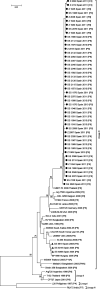Rotavirus genotypes in children in the Basque Country (North of Spain): rapid and intense emergence of the G12[P8] genotype
- PMID: 22873952
- PMCID: PMC9151868
- DOI: 10.1017/S0950268812001306
Rotavirus genotypes in children in the Basque Country (North of Spain): rapid and intense emergence of the G12[P8] genotype
Abstract
Between July 2009 and June 2011, rotavirus was detected in 507 of 4597 episodes of acute gastroenteritis in children aged <3 years in Gipuzkoa (Basque Country, Spain), of which the G-type was determined in 458 (90·3%). During the annual seasonal epidemic of 2010-2011, the unusual G-type 12 was predominant, causing 65% (145/223) of cases of rotavirus gastroenteritis. All the G12 strains were clustered in lineage III and were preferentially associated with P-type 8. This epidemic was characterized by broad geographical distribution (rural and urban) and, over 7 months, affected both infants and children, the most frequently affected being children between 4 and 24 months. Of children with rotavirus G12, 16% required hospital admission, the admission rate in children aged <2 years being 20·7 cases/10 000 children. The sudden emergence and predominance of G12 rotaviruses documented in this winter outbreak suggest that they may soon become a major human rotavirus genotype.
Figures


Similar articles
-
Genotypes of rotavirus associated with acute gastroenteritis in Seoul, Korea.Microbiol Immunol. 2011 Sep;55(9):641-4. doi: 10.1111/j.1348-0421.2011.00366.x. Microbiol Immunol. 2011. PMID: 21752085
-
Molecular epidemiology of Rotavirus causing diarrhea among children less than five years of age visiting national level children hospitals, Nepal.BMC Pediatr. 2017 Apr 7;17(1):101. doi: 10.1186/s12887-017-0858-0. BMC Pediatr. 2017. PMID: 28388889 Free PMC article.
-
Phylogenetic analysis of VP7 and VP4 genes of the most predominant human group A rotavirus G12 identified in children with acute gastroenteritis in Himachal Pradesh, India during 2013-2016.J Med Virol. 2021 Nov;93(11):6200-6209. doi: 10.1002/jmv.27142. Epub 2021 Jun 24. J Med Virol. 2021. PMID: 34138482
-
The molecular epidemiology of circulating rotaviruses: three-year surveillance in the region of Monastir, Tunisia.BMC Infect Dis. 2011 Oct 3;11:266. doi: 10.1186/1471-2334-11-266. BMC Infect Dis. 2011. PMID: 21967503 Free PMC article.
-
Molecular epidemiology of G12 rotavirus strains during eight consecutive epidemic seasons in the Basque Country (North of Spain), 2010-2018.Infect Genet Evol. 2019 Jul;71:67-75. doi: 10.1016/j.meegid.2019.03.016. Epub 2019 Mar 21. Infect Genet Evol. 2019. PMID: 30905774
Cited by
-
Detection and Molecular Characterization of Rotavirus Infections in Children and Adults with Gastroenteritis from Vojvodina, Serbia.Microorganisms. 2022 Oct 17;10(10):2050. doi: 10.3390/microorganisms10102050. Microorganisms. 2022. PMID: 36296326 Free PMC article.
-
Predominance of rotavirus G1[P8] genotype among under-five children with gastroenteritis in Mwanza, Tanzania.J Trop Pediatr. 2014 Oct;60(5):393-6. doi: 10.1093/tropej/fmu028. Epub 2014 May 24. J Trop Pediatr. 2014. PMID: 24859323 Free PMC article.
-
Introduction and prolonged circulation of G12 rotaviruses in Sicily.Epidemiol Infect. 2016 Jul;144(9):1943-50. doi: 10.1017/S0950268815003258. Epub 2016 Jan 8. Epidemiol Infect. 2016. PMID: 26743189 Free PMC article.
-
Review of global rotavirus strain prevalence data from six years post vaccine licensure surveillance: is there evidence of strain selection from vaccine pressure?Infect Genet Evol. 2014 Dec;28:446-61. doi: 10.1016/j.meegid.2014.08.017. Epub 2014 Sep 16. Infect Genet Evol. 2014. PMID: 25224179 Free PMC article. Review.
-
Reverse Genetics Approach for Developing Rotavirus Vaccine Candidates Carrying VP4 and VP7 Genes Cloned from Clinical Isolates of Human Rotavirus.J Virol. 2020 Dec 22;95(2):e01374-20. doi: 10.1128/JVI.01374-20. Print 2020 Dec 22. J Virol. 2020. PMID: 33087468 Free PMC article.
References
-
- Tate JE, et al.; the WHO-coordinated Global Rotavirus Surveillance Network. 2008 estimate of worldwide rotavirus-associated mortality in children younger than 5 years before the introduction of universal rotavirus vaccination programmes: a systematic review and meta-analysis. Lancet Infectious Diseases 2011; 12: 136–141. - PubMed
-
- World Health Organisation.Rotavirus vaccines: an update. Weekly Epidemiological Record 2009; 84: 533–537. - PubMed
-
- Patel MM, et al. Real-world impact of rotavirus vaccination. Pediatric Infectious Diseases Journal 2011; 30 (Suppl. 1): S1–5. - PubMed
-
- Santos N, Hoshino Y. Global distribution of rotavirus serotypes/genotypes and its implication for the development and implementation of an effective rotavirus vaccine. Reviews in Medical Virology 2005; 15: 29–56. - PubMed
Publication types
MeSH terms
Substances
LinkOut - more resources
Full Text Sources
Medical

